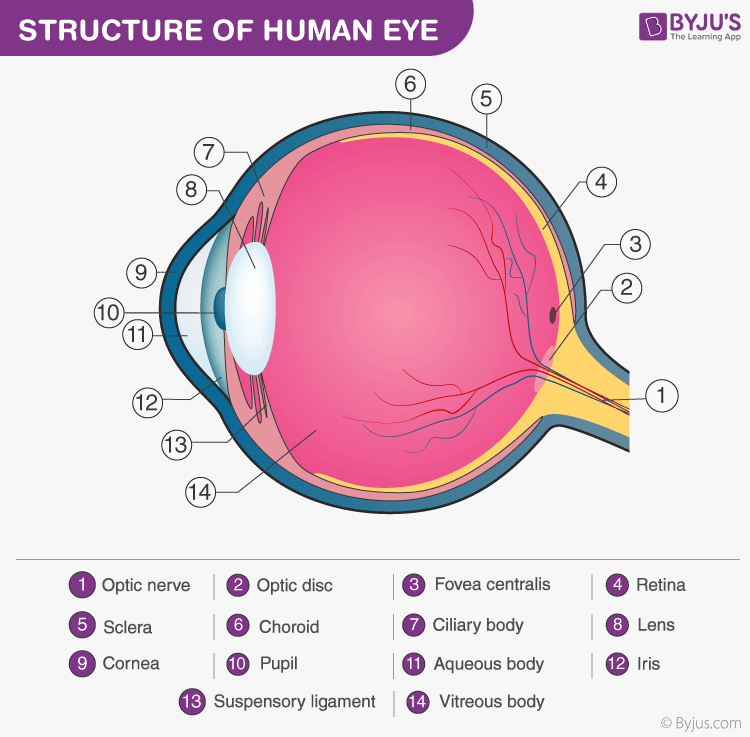Retina is the innermost light-sensitive layer of the eye. It is a thin layer of tissues that lines the back of the eyeball. Here, let’s discuss more about the retina and the layers of the retina.
Table of Content:
What is Retina?
Retina is the innermost layer of the eyeball. It is the light-sensitive layer of the eye and acts as a film of a camera where an image is formed.
Retina is primarily made up of three layers of nerve cells, these are ganglion cells, bipolar cells and photoreceptor cells. Ganglion cells are present closest to the vitreous body. The primary light-sensitive layer is of photoreceptor cells, which is made up of rods and cones. The image gets translated into neural impulses which travel to the brain for visual perception.

Layers of Retina
Retina is present at the posterior portion of the eyeball. Retina comprises 10 distinct layers, which are formed by different types of neural cells and their synapses. The 10 layers of retina starting from the vitreous chamber are the following:
- Inner limiting membrane – consists of the basement membrane and contains Müller cells.
- Nerve fibre layer (NFL) – axons of ganglion cells.
- Ganglion cell layer – nuclei of ganglion cells and some amacrine cells.
- Inner plexiform layer – synapse between dendrites of ganglion cells and axons of bipolar cells.
- Inner nuclear layer – nuclei of bipolar cells, amacrine cells and horizontal cells.
- Outer plexiform layer – synapse between dendrites of bipolar cells and horizontal cells with rods and cones.
- Outer nuclear layer – contains cell bodies of rods and cones.
- Outer or External limiting membrane – separates inner segments of photoreceptor cells from cell nuclei.
- The layer of rods and cones – contains inner and outer segments of rods and cones.
- Retinal pigment epithelium – consists of cuboidal epithelium and provides nourishment to neural cells. It provides retinal. It also contains melanin, which decreases scattering of light.
Three primary layers of retina
There are primarily three distinct layers of neurons consisting of ganglion cells, bipolar cells and photoreceptor cells (rods and cones), which relay the information.
Photoreceptive layer
It is present nearest to the choroid. The light has to pass through the other two layers to reach the photoreceptor cells. There are two types of photoreceptor cells, namely rods and cones.
- Rods – responsible for scotopic or twilight vision. They detect dim light and contain rhodopsin photopigment, which is a derivative of vitamin A.
- Cones – responsible for photopic or daylight vision. They detect bright light and are responsible for colour vision. There are three types of cones in the human eye, which contain different types of photopigments responding to red, green and blue light.
Also see: Difference between Rods and Cones
Bipolar Cell Layer
They constitute the middle layer and receive the signal from photoreceptor cells. The bipolar cells synapse with both rods and cones and ganglion cells. They transmit the signal from photoreceptor cells to ganglion cells.
Apart from bipolar cells, there are two types of lateral interneurons present in the middle layer, namely horizontal cells and amacrine cells. They help in relaying information within the retina.
- Horizontal cells – they receive impulses from photoreceptor cells and transmit it to bipolar cells.
- Amacrine cells – they relay information between bipolar cells or from bipolar cells to ganglion cells.
Ganglion cell layer
Ganglion cells receive signals from bipolar cells. The axons of ganglion cells unite to form optic nerve, which transmits the signal to thalamus for further processing by the brain. The visual cortex area of the brain processes the nerve impulses and the image is recognised.
Blind spot – It is the area where the optic nerve passes. It does not contain rods and cones so images falling here cannot be perceived.
This basic three layered structure of retina is common in most of the vertebrates.
This was in brief about layers of retina. Test your understanding with MCQs on Structure of Eye, only at BYJU’S.
Frequently Asked Questions
What are the three layers of the retina?
There are three primary layers in the retina that are made up of nerve cells or neurons. These are the photoreceptor cell layer, ganglion cell layer and bipolar cell layer.
What are photoreceptor cells?
Photoreceptor cells are the primary light-sensing cells in the retina. There are two types of photoreceptor cells, namely rods and cones. The rods are responsible for scotopic or twilight vision and the cones are responsible for photopic or daylight vision.
What is an optic nerve?
It is a paired cranial nerve that aids in transmitting visual details from the retina to the brain. This nerve is composed of glial cells and retinal ganglion cell axons.
Related Articles:
| Sensory Receptors |
| Process of Neural Communication |
| NEET Biology Flashcards – Neural Control and Coordination |

Comments